TourFest 2024 | When Art Meets Nature : A New Relationship to Our Environment Amongst Straw Bales
Nell'arena delle balle di paglia a Cotignola
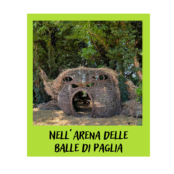 From Bologna, take a train to Faenza. There, take another train, or a bus, or your car, and go to Cotignola. Then you can keep going by foot, or bike if you can find one for your staying. Find Cenacchio Street, exit Cotignola. Keep going until you find, on the left roadside, a sign where you can read “Nell’Arena delle Balle di Paglia”. Follow the marked path between the Emiliano-Romagnolo canal and a vast vineyard. After a little slope, behind a high tree line, you will enter this great field that hosts, from July the 10th to the 16th the sixteenth edition of the festival named Nell’Arena delle Balle di Paglia. Lost in the countryside of Faenza, near the Senio torrent, above the Emiliano-Romagnolo canal, you will discover a beautiful whole new world, handmade by the cultural association Primola Cotignola and some volunteers: an amphitheatre made in straw bales sprinkled with land arts hidden in the natural environment.
From Bologna, take a train to Faenza. There, take another train, or a bus, or your car, and go to Cotignola. Then you can keep going by foot, or bike if you can find one for your staying. Find Cenacchio Street, exit Cotignola. Keep going until you find, on the left roadside, a sign where you can read “Nell’Arena delle Balle di Paglia”. Follow the marked path between the Emiliano-Romagnolo canal and a vast vineyard. After a little slope, behind a high tree line, you will enter this great field that hosts, from July the 10th to the 16th the sixteenth edition of the festival named Nell’Arena delle Balle di Paglia. Lost in the countryside of Faenza, near the Senio torrent, above the Emiliano-Romagnolo canal, you will discover a beautiful whole new world, handmade by the cultural association Primola Cotignola and some volunteers: an amphitheatre made in straw bales sprinkled with land arts hidden in the natural environment.
After a few days alone in the city of Genova and a long train journey to Bologna, to enter the straw bales arena was like putting a foot in a heavenly place, where all my worries were flushed by the sight of this unusual place and its friendly atmosphere. As soon as I parked the bike kindly lended to me by the staff of the festival, I was guided through the multiple places that compose the festival. From the Golena dei Poeti (Poets’ Floodplain) to the Vitalba village, through the central stage and the Cupola di bambù (bamboo dome); between these trees and straw bales, everybody’s needs and desires can be met, no matter your age, your hobbies nor where you come from. You can take a drink and sit on a straw bale in the Golena dei Poeti or above the Golena, in the grass, to get an overview to attend a clown performance by Matteo Galbusera for kids and adults. Or you can attend a conference led by Andrea Gavazzoli about sustainability entitled Otto storie di ordinaria sostenibilità (Eight Stories of Ordinary Sustainability) in the bamboo dome. Then, the main shows begin on the central stage. You can order a piadina amongst a variety of piadine and other snacks (with some vegan, vegetarian and gluten free options!) to eat next to the central stage while listening to the Microband in concerto with Luca Domenicali and Danilo Maggio (July the 15th) or the Mefisto Brass concert (July the 16th), and sit on another straw bale to keep following the show. Do not forget to sort your waste in the dedicated bins! The festival thought about it: to make sure you do not forget, the bins are enlightened like a piece of art in a museum. You can also count on a cleaning agent to supervise and guide you if you need any help to do it!
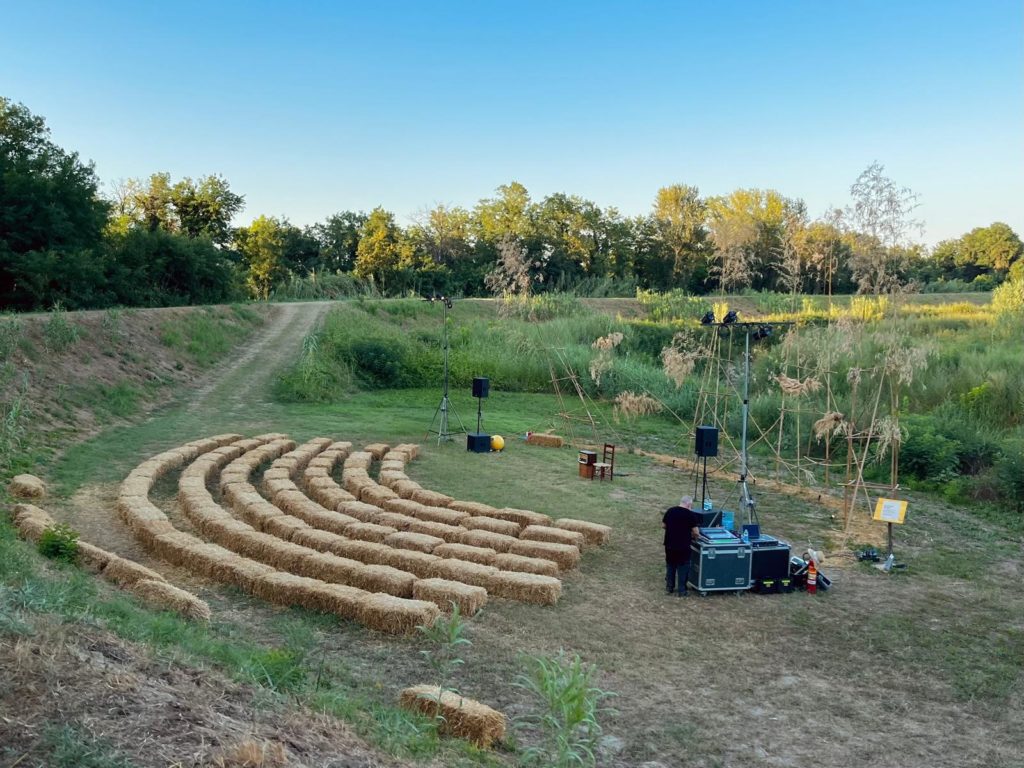
Golena dei Poeti
Children are far from being left aside. This whole word has been designed for everyone, including the youngsters. The first thing you see when you pass the festival entrance is a gigantic (from a child point of view) straw pool, where one can dive with their friends. Through the eyes of this same child, the entire place is a real playground: one can run around the place, hide between trees, jump from a straw bale to another. But the icing on the cake is the Arena Bambini, housed in the trees, guarded by the God and King of Winds Aeolus. As Pinocchio entered the whale through its mouth, enter Aeolus’ mouth to discover another world, a crafty one, a museum of the workshops that took place in the evening. Some child paintings are hung between the trees, coloured knitted leaves blend amongst other real leaves and paper flowers. For a moment, it made me want to go back in time to my childhood to do some workshops inside the Arena Bambini, to enter Aeolus’ mouth and learn again how to knit, or make some paper flowers under the crystals hung on the tree or go dive in the straw pool among the other kids. Besides the workshops you can also find some shows in the Arena Bambini’s programme. This is the case of the in situ performance by Lorenzo di Bonifico, Gli esploratori del CER, guiding the children through an exploration of the Emiliano Romagnolo canal leading to a global thought on the water in the countryside.
If you get tired of the party’s heart, you can explore the Vitalba village, in search of some piece of art scattered in the trees or the grass along the path. Follow the marked path and pay attention to your surroundings. Look closely at the trees: some of these are adorned by Megx’s sculptures (IG: @___megx__) that blend into the landscape. You can take a pause in your exploration inside the Veliero del villaggio Vitalba (sailing ship of the Vitalba village), entirely made of wood, remaining from the previous festival’s editions. There, take the time to appreciate the song of the plants made audible with our contact through an installation by Enzo Cimino (https://www.enzocimino.com/). Bystanders touch and pet the plant, their roots, their leaves, creating a smooth melody by this contact between human and nature. If you go further in the Vitalba village, you can reach the end of the alley, to a pond with a giant bird of wood made by the duo Ars Ruralis (IG: @ars_ruralis) (you can find other pieces of their work everywhere in the festival place!), leading to the palafitta per le formiche (the stilt house for the ants), a balcony from where you can enjoy the overview on the sea of vines, soothed by the distant sound of the party. To go back to the central stage, you can take another path, and look inside telescopes to discover paintings by Claudio Montini, a local painter whose work is being showcased in this part of the festival.
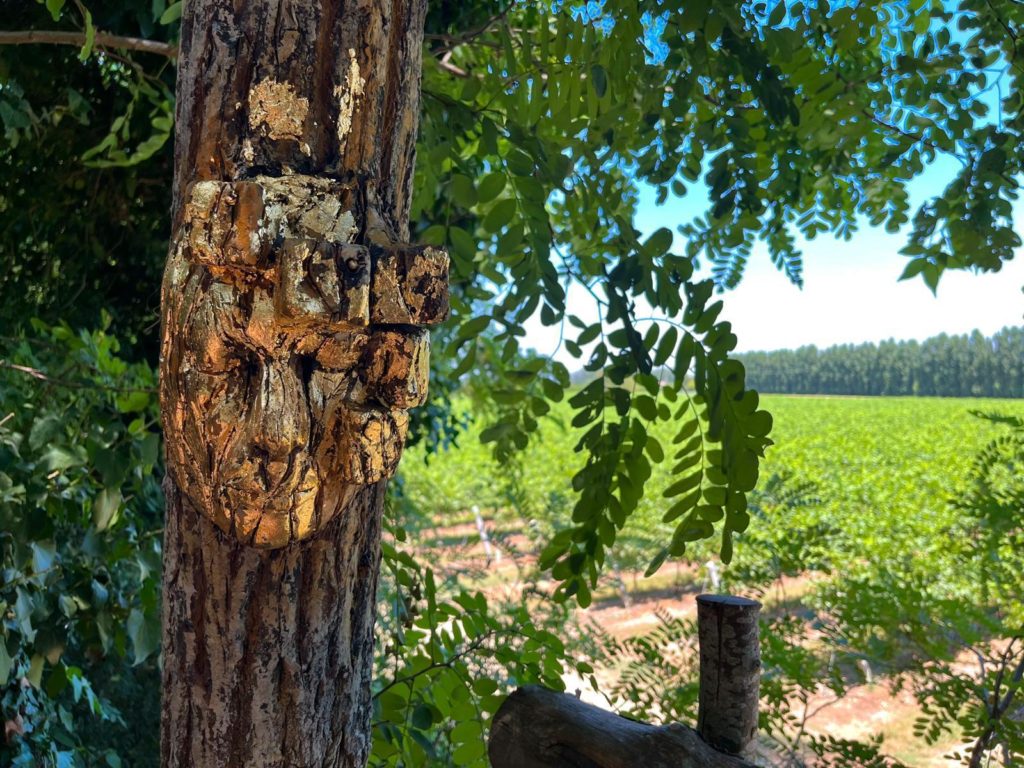
Sculpture by Megx (Margherita Burcini)
Hidden in the Arena, all of these land art pieces put nature and our relationship with it under a new light. It is a great and interesting way to explore a new relationship with our environment. By making the audience look carefully at their surroundings in search of an artistic surprise, we are guided by Primola (and the artists invested) in the establishment of a new connection with nature, which is more than welcome in nowadays’ society, where we lost contact with earth and plants. After a few moments wandering in this vast place, I happened to wonder if that thing is a handmade piece of art or a simple natural coincidence. I surprised myself by gazing at a spiderweb enlightened by the setting sun with as much (or even more) attention as a Monet painting in a museum.
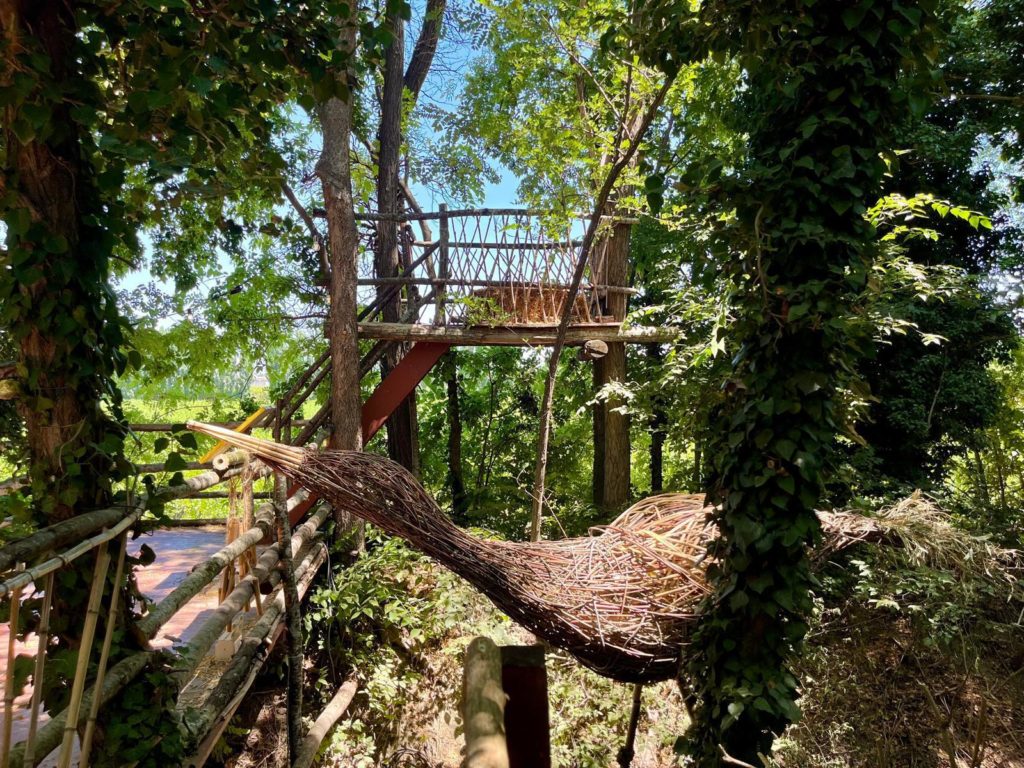
L’uccello parla al folle, by Ars Ruralis on the foreground, and the Palafitta per le formiche, designed by Giuseppe Russi in the background.
Such a journey Nell’Arena delle Balle di Paglia gives us consciousness of the natural beauty of our environment. In the Arena, arts give pride of place to the natural environment it has invested in. Stages for shows are made with wood and adorned by some simple but impressive wooden sculptures. The main stage is located in front of a great tree wall, giving the audience a breathtaking view on these overhanging trees enlightened by the shows’ lights. The festival itself is a masterpiece inside the masterpiece of nature, and this is what Primola tends to do there: to promote the natural environment through arts, and showcase its magnificence. In front of such a masterpiece of a festival lost in nature, you tend to develop your own philosophical thoughts. And as Pascal questioned the very place of humanity in the world, you can begin like that: “For, after all, what is man in nature?” (Pascal, Pensées, (Thoughts), Paris, 1670).
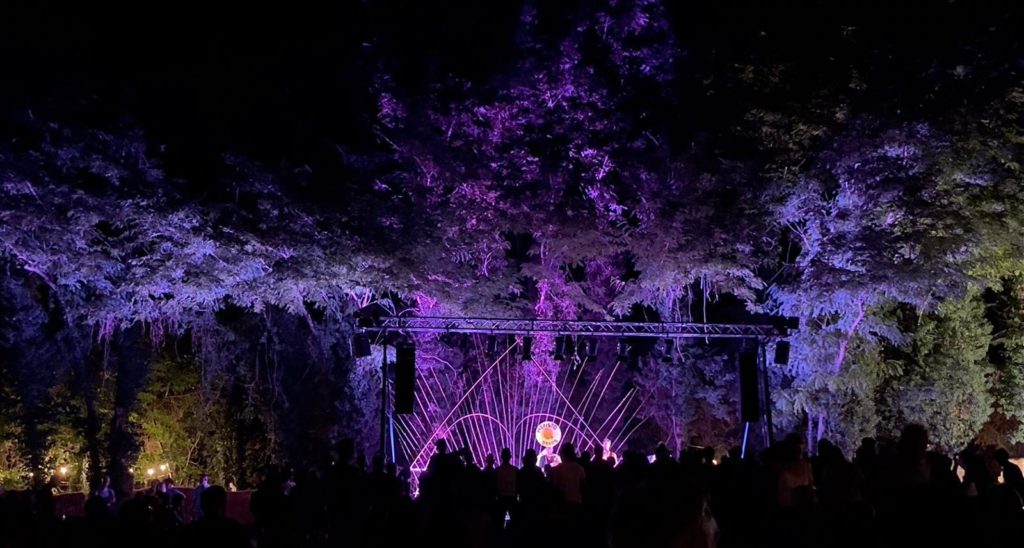
The central stage during the Mephisto Brass concert, July the 16th.
Tag: natura e teatro (7)







